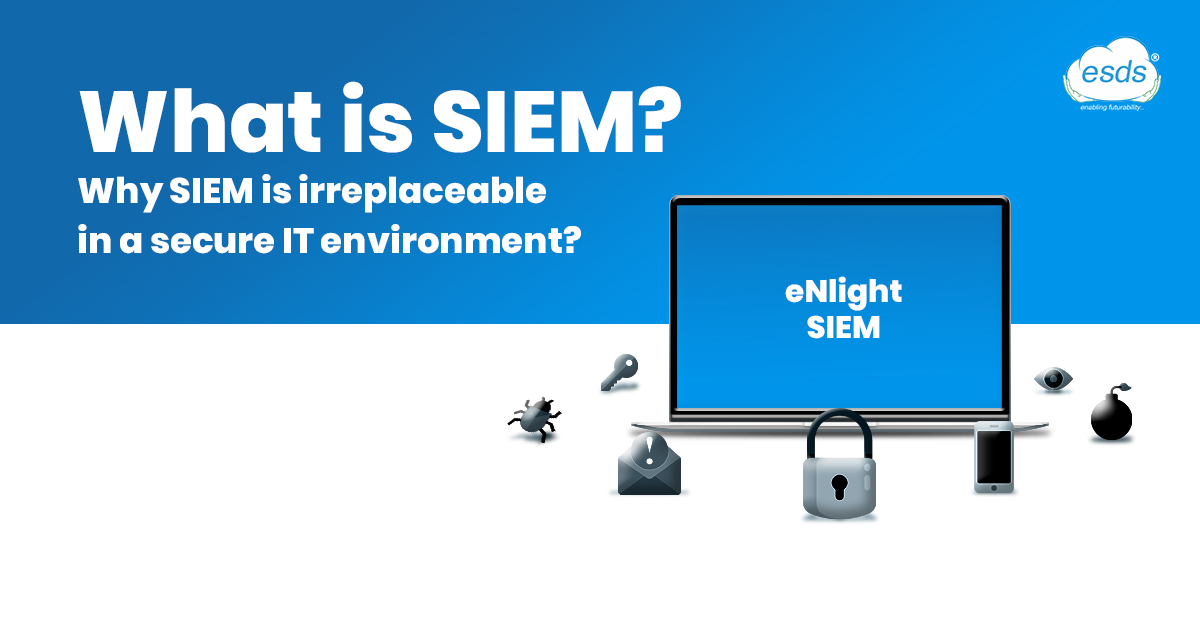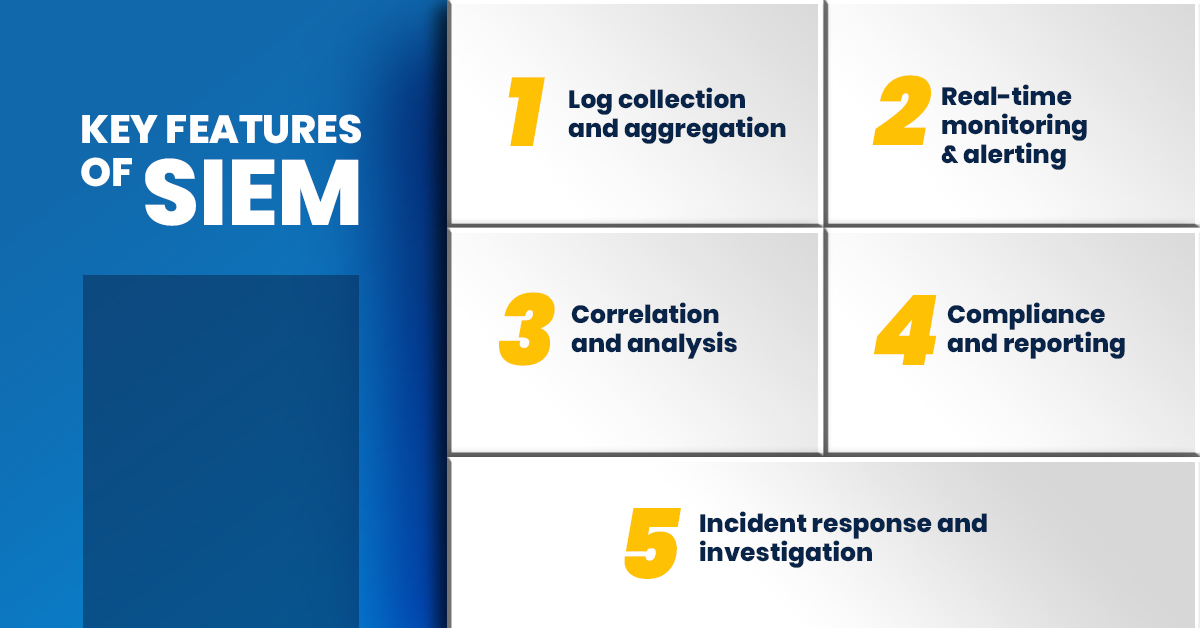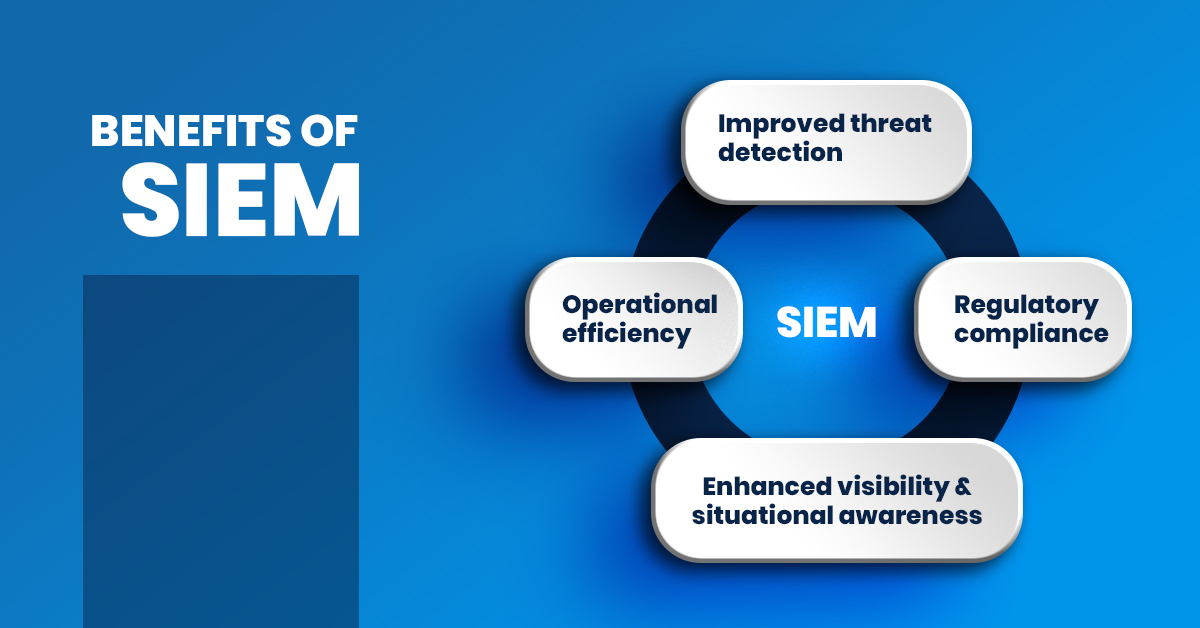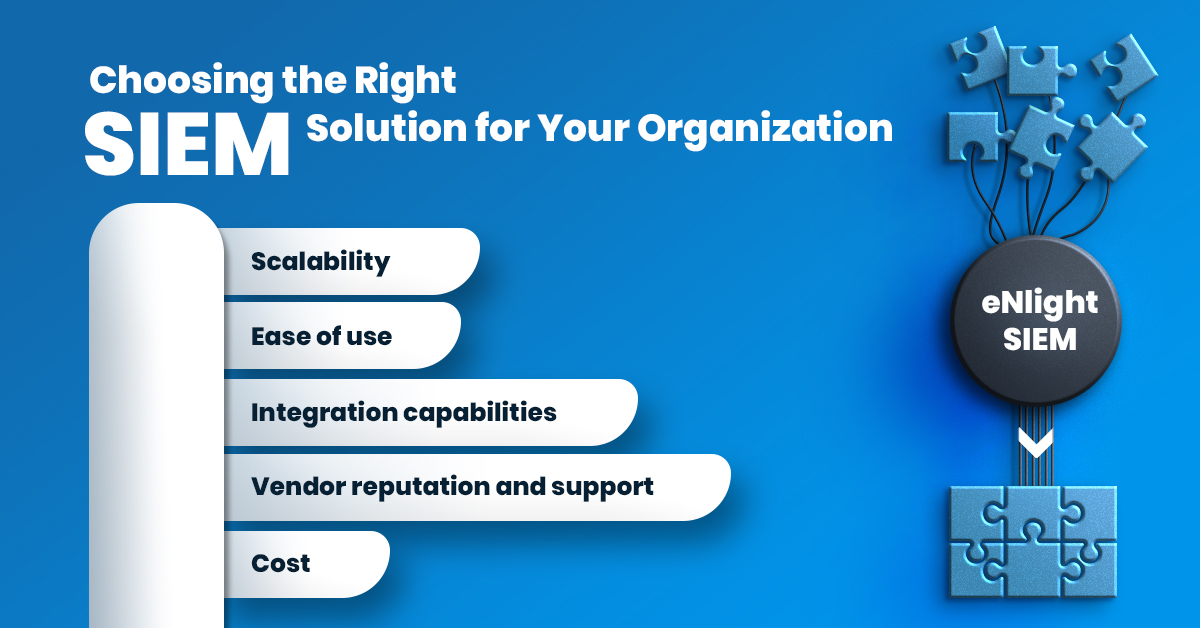What is SIEM? Why SIEM is irreplaceable in a secure IT environment?

In today’s interconnected world, where organizations rely heavily on technology for their day-to-day operations, the importance of IT security cannot be overstated. A single security breach can have severe consequences, ranging from financial loss to reputational damage. In a recent survey conducted by the Deloitte Center for Controllership, findings reveal that cyber adversaries targeted the accounting and financial data of 34.5% of polled executives’ organizations over the past year. Among those affected, 22% encountered at least one cyber event, while 12.5% faced multiple incidents. Furthermore, an alarming 48.8% of C-suite and other executives anticipate a rise in the frequency and magnitude of cyber events aimed at their organizations’ accounting and financial data in the coming year. These statistics underscore the growing concerns surrounding cybersecurity in the financial sector. With cyber threats constantly evolving, organizations need to stay one step ahead to protect their sensitive data and critical assets. Traditional security measures, such as firewalls and antivirus software, are no longer sufficient.
The need for a comprehensive security solution that can detect and respond to advanced threats in real time has become paramount. That’s where Security Information and Event Management (SIEM) comes into play. SIEM is not just another acronym in the cybersecurity world; it is a powerful tool that unlocks the potential to safeguard your organization against modern threats. With its ability to collect, correlate, and analyze vast amounts of security data, SIEM provides invaluable insights into the activities happening within your IT infrastructure. By identifying patterns and anomalies, SIEM enables you to detect and respond to potential threats in real-time, preventing breaches before they can cause irreparable damage. In this article, we will delve into the world of SIEM, exploring how it works, its key benefits, and why it should be an integral part of your cybersecurity strategy. Get ready to uncover the power of SIEM and take your IT security to the next level.
What is SIEM and How Does It Work?
SIEM stands for Security Information and Event Management. It is a technology that combines Security Information Management (SIM) and Security Event Management (SEM) capabilities to provide a holistic view of an organization’s security posture. SIEM solutions collect and aggregate log data from various sources, such as network devices, servers, applications, and security tools. This data is then normalized, correlated, and analyzed to identify potential security incidents. SIEM systems use advanced analytics and machine learning algorithms to detect patterns and anomalies that may indicate malicious activity. By centralizing security data and providing real-time visibility into events happening within an IT environment, SIEM enables organizations to proactively detect and respond to threats.
Key Features and Benefits of SIEM

SIEM offers a range of features and benefits that make it an essential tool for modern cybersecurity. Some of the key features of SIEM include:
- Log collection and aggregation: SIEM solutions can collect, aggregate, and normalize log data from various sources, including network devices, servers, operating systems, applications, and security tools. This centralized approach allows for easy analysis and correlation of security events.
2. Real-time monitoring and alerting: SIEM systems continuously monitor security events and generate real-time alerts when suspicious activities or potential threats are detected. This enables organizations to respond quickly and effectively to security incidents.
3. Correlation and analysis: SIEM solutions use advanced analytics and machine learning algorithms to correlate and analyze security events in real time. By identifying patterns and anomalies, SIEM can detect potential threats that may go unnoticed by traditional security tools.
4. Incident response and investigation: SIEM provides organizations with the ability to investigate security incidents by providing detailed logs and audit trails. This helps in understanding the scope and impact of an incident and facilitates effective incident response.
5. Compliance and reporting: SIEM solutions can assist organizations in meeting regulatory compliance requirements by providing comprehensive reporting capabilities. SIEM can generate compliance reports, track user activity, and demonstrate adherence to industry-specific regulations.
The benefits of SIEM are vast and include:
- Improved threat detection: SIEM enables organizations to detect and respond to potential threats in real-time, minimizing the impact of security incidents and preventing breaches before they can cause irreparable damage.
2. Enhanced visibility and situational awareness: SIEM provide a centralized view of security events happening within an IT environment. This visibility allows organizations to identify and address security gaps, as well as gain insights into user behavior and system vulnerabilities.
3. Operational efficiency: SIEM automates the collection, correlation, and analysis of security events, reducing the manual effort required for security monitoring and incident response. This allows security teams to focus on strategic tasks and improve overall operational efficiency.
4. Regulatory compliance: SIEM solutions help organizations meet regulatory compliance requirements by providing the necessary tools and reports to demonstrate adherence to industry-specific regulations.

Implementing SIEM in Your IT Environment
Implementing SIEM in your IT environment requires careful planning and consideration. Here are some key steps to follow:
- Define your objectives: Before implementing SIEM, clearly define your objectives and what you hope to achieve with the technology. Identify the specific security challenges you want to address and the desired outcomes.
2. Assess your IT environment: Conduct a thorough assessment of your IT environment to understand the types of data sources you need to monitor and the volume of logs generated. This will help you determine the scalability requirements of your SIEM solution.
3. Select the right SIEM solution: Choose a SIEM solution that aligns with your organization’s needs and requirements. Consider factors such as scalability, ease of use, integration capabilities, and vendor reputation.
4. Plan for data collection and normalization: Determine the data sources you want to monitor and ensure that you have the necessary log collection agents in place. Define the log collection and normalization process to ensure that all relevant security events are captured.
5. Configure correlation rules and alerts: Configure correlation rules and alerts based on your organization’s specific security requirements. This will help the SIEM system identify patterns and anomalies that may indicate potential threats.
6. Integrate with other security tools: SIEM should be integrated with other security tools, such as intrusion detection systems, firewalls, and vulnerability scanners, to provide a comprehensive security posture. This integration allows for better visibility and correlation of security events.
7. Train your security team: Provide training to your security team on how to effectively use the SIEM solution. This will ensure that they can maximize the benefits of SIEM and respond to security incidents in a timely and efficient manner.
Common Challenges and Considerations
Implementing and managing a SIEM solution can come with its own set of challenges. Some common challenges organizations may face include:
- Data overload: SIEM solutions can generate a large volume of security events and logs, which can overwhelm security teams. It is important to define what data is relevant and prioritize alerts to avoid alert fatigue.
2. Skill requirements: SIEM solutions require skilled analysts who can effectively analyze and respond to security events. Organizations may need to invest in training or hire specialized personnel to manage the SIEM system.
3. Scalability: As the volume of data and security events increases, organizations need to ensure that their SIEM solution can scale accordingly. This may involve adding additional hardware or leveraging cloud-based SIEM solutions.
4. Integration with existing systems: Integrating SIEM with existing security tools and systems can be complex. It is important to ensure that the SIEM solution can effectively collect and correlate data from these sources.
When considering a SIEM solution, organizations should take into account the following considerations:
- Scalability: Ensure that the SIEM solution can scale as your organization grows and the volume of security events increases.
- Ease of use: Look for a SIEM solution that is intuitive and easy to use, with a user-friendly interface and robust reporting capabilities.
- Integration capabilities: Check if the SIEM solution can integrate with your existing security tools and systems, such as firewalls, intrusion detection systems, and vulnerability scanners.
- Vendor reputation and support: Choose a SIEM solution from a reputable vendor with a track record of providing reliable support and regular software updates.
Best Practices for Maximizing SIEM Effectiveness
To maximize the effectiveness of your SIEM solution, consider the following best practices:
- Define clear security policies: Clearly define your organization’s security policies and procedures. This will help in configuring correlation rules and alerts that align with your security requirements.
- Regularly review and update correlation rules: Security threats evolve over time, so it is important to regularly review and update your correlation rules to keep up with the latest threats and attack techniques.
- Conduct regular log reviews: Regularly review and analyze log data to identify any suspicious activities or potential threats. This will help in detecting security incidents at an early stage.
- Regularly update and patch your SIEM solution: Keep your SIEM solution up to date with the latest software updates and patches. This ensures that you have the latest security features and bug fixes.
- Perform regular security assessments: Conduct regular security assessments to identify vulnerabilities and gaps in your IT environment. Use the insights gained from these assessments to fine-tune your SIEM configuration and improve your overall security posture.
Integrating SIEM with Other Security Tools
While SIEM provides valuable insights into security events happening within your IT environment, integrating it with other security tools can further enhance your organization’s security posture. By integrating SIEM with tools such as intrusion detection systems (IDS), firewalls, and vulnerability scanners, you can gain a more comprehensive view of your organization’s security landscape. This integration allows for better correlation and analysis of security events, enabling you to detect and respond to threats more effectively.
When integrating SIEM with other security tools, consider the following:
- Determine the data to be shared: Identify the specific data or events that need to be shared between the SIEM and other security tools. This could include alerts, logs, or threat intelligence data.
- Define integration points: Determine how the SIEM will communicate with other security tools. This could be through APIs, Syslog, or other integration methods supported by the respective tools.
- Configure correlation rules: Configure correlation rules in your SIEM solution to make use of the additional data provided by the integrated security tools. This will help in identifying complex attack scenarios and potential threats.
- Monitor and fine-tune integrations: Continuously monitor the integration between SIEM and other security tools to ensure that data is being shared effectively. Regularly review and fine-tune correlation rules to improve the accuracy of threat detection.
SIEM for Compliance and Regulatory Requirements
SIEM solutions play a crucial role in helping organizations meet compliance requirements imposed by industry regulations and standards. By providing comprehensive reporting capabilities and tracking user activity, SIEM solutions assist organizations in demonstrating adherence to regulatory requirements. Some common compliance standards that SIEM can help with include the Payment Card Industry Data Security Standard (PCI DSS), General Data Protection Regulation (GDPR), and Health Insurance Portability and Accountability Act (HIPAA).
When using SIEM for compliance purposes, consider the following:
- Identify relevant compliance requirements: Determine the specific compliance requirements that your organization needs to meet. This could include data protection, access control, or incident response.
- Configure compliance reports: Configure your SIEM solution to generate compliance reports that align with the specific requirements of the regulations or standards you need to comply with. This will help in demonstrating adherence to these requirements during audits.
- Implement user activity monitoring: Use the user activity monitoring capabilities of your SIEM solution to track and analyze user behavior. This can help in identifying any unauthorized access or suspicious activities that may violate compliance requirements.
- Regularly review and update policies: Regularly review and update your security policies and procedures to ensure that they align with the latest compliance requirements. This includes reviewing and updating correlation rules and alerts in your SIEM solution.
Case Studies: Real-World Examples of SIEM Success
To understand the real-world impact of SIEM, let’s look at a couple of case studies:
Case Study 1: Financial Services Company
A financial services company implemented a SIEM solution to improve their overall security posture and meet regulatory compliance requirements. The SIEM solution allowed them to collect and correlate security events from various sources, including firewalls, servers, and intrusion detection systems. By analyzing the data collected, the SIEM system detected multiple instances of unauthorized access attempts and potential insider threats. This enabled the company to take immediate action and prevent any data breaches. The SIEM solution also provided the necessary reporting capabilities to demonstrate compliance with industry regulations.
Case Study 2: Healthcare Organization
A healthcare organization implemented a SIEM solution to enhance their security monitoring capabilities and protect patient data. The SIEM system collected and analyzed security events from various sources, such as electronic health record systems, network devices, and access control systems. The SIEM solution helped the organization detect and respond to potential threats in real-time, preventing any unauthorized access to patient records. Additionally, the SIEM system enabled the organization to demonstrate compliance with HIPAA requirements through comprehensive reporting capabilities.
These case studies highlight the effectiveness of SIEM in improving security posture, detecting threats, and meeting compliance requirements.

Choosing the Right SIEM Solution for Your Organization
Choosing the right SIEM solution for your organization is crucial to ensure its effectiveness and alignment with your specific needs. When evaluating SIEM solutions, consider the following factors:
- Scalability: Ensure that the SIEM solution can scale as your organization grows and the volume of security events increases.
- Ease of use: Look for a SIEM solution that is intuitive and easy to use, with a user-friendly interface and robust reporting capabilities.
- Integration capabilities: Check if the SIEM solution can integrate with your existing security tools and systems, such as firewalls, intrusion detection systems, and vulnerability scanners.
- Vendor reputation and support: Choose a SIEM solution from a reputable vendor with a track record of providing reliable support and regular software updates.
- Cost: Consider the cost of the SIEM solution, including licensing, maintenance, and any additional hardware or infrastructure requirements.
By carefully evaluating these factors, you can select a SIEM solution that meets your organization’s specific requirements and maximizes the effectiveness of your cybersecurity strategy.
Conclusion and the Future of SIEM in Cybersecurity
In an increasingly interconnected and threat-filled digital landscape, SIEM has emerged as a powerful tool for protecting IT environments against modern threats. By collecting, correlating, and analyzing vast amounts of security data, SIEM provides organizations with
- Top 5 Data Center Trends for 2024 - October 11, 2023
- Top 15 Cloud Computing Trends 2024 - October 4, 2023
- What is Infrastructure Monitoring and Why Infrastructure Monitoring Tool is Important for Your Business? - September 20, 2023
